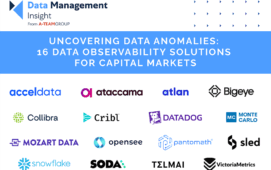
When global markets were roiled by the announcement of massive US trade tariffs, Bloomberg saw the amount of financial and other data that runs through its systems surge to 600 billion data points, almost double the 400 billion it manages on an average day.
“These were just mind-blowingly large volumes of data,” says James Jarvis, Bloomberg BQuant Desktop Product Manager. “Add to that the unstructured data that we receive through Bloomberg News and other sources. It’s a vast quantity of data.”
Far from being overburdened by such data overload, however, the company’s clients are able to take that information in their stride and make valuable and actionable sense of it all. Bloomberg’s BQuant turnkey quantitative analysis and data science solution is a suite of tools that enable financial institutions to integrate large volumes of data into a programmable environment where they can create analytics and other workflows to help inform their investment decisions and aid in other critical use cases.
AI Capabilities
Introduced about eight years ago, BQuant builds on a host of Bloomberg functionality, including its artificial intelligence capabilities that the company has been developing for deployment in its products since 2009.
BQuant’s ability to tap Bloomberg’s vast pools of data and apply that information to multitudinous uses has made it a winner of A-Team Group’s AI in Capital Markets Best AI Solution for Historical Data Analysis Award.
These awards were created to recognise the AI and machine learning solutions that deliver tangible, real-world value to financial institutions across the globe. Winners were recognised for their innovative work across data management, trading technology, RegTech and ESG.
BQuant is available as BQuant Desktop, within the Bloomberg Anywhere subscription, and BQuant Enterprise.
BQuant Desktop gives enabled Bloomberg Terminal users programmatic access to Bloomberg data and analytics in a secure sandbox environment, where they can quickly develop and refine different strategies, enabling them to get new ideas to market fast.
BQuant Enterprise is a fully managed, cloud-based analytics platform that enables financial institutions to scale investment workflows with advanced compute power, broad access to Bloomberg data, integration with their own internal systems, and seamless collaboration.
Flexibility is Key
AI is also deployed to generate intelligent metadata that makes the underlying data usable, traceable and, importantly, trusted. As well, it makes possible sentiment analysis and pattern recognition to power investment research.
“We always like to think about the problems that clients have and how we can provide them with the tools to solve for them,” explains Jarvis from his office in New York.
“But rather than try to design a very specific solution to a very specific problem that’s the end of the story, we try to think about the individual components that go into solving that problem… so flexibility is at the heart of all of this.”
With BQuant regularly updated, clients include some of the largest financial institutions in the world. Among the most recent institutions to have adopted the service is Mitsubishi UFJ Asset Management, which has deployed BQuant Enterprise as part of its digital transformation.
“As we strive to realise Japan as a nation of asset management, enhancing our operational capabilities is an urgent task,” said Akira Takanabe, Chief Investment Officer of Mitsubishi UFJ Asset Management. “BQuant Enterprise allows us to drive innovation faster and more efficiently than building these systems ourselves.”
Jarvis, a former foreign exchange trader who is well aware of the programming needs of both buy- and sell-side professionals, explains that BQuant’s flexibility is chiefly the result of being built on Python. The “go-to tool of choice for people working with large volumes of data” makes BQuant at once easy to adapt to any application and quick to learn.
Python’s power resides in its elegant simplicity.
“It is popular, in part, because it is an easy language to learn – people that know how to code Python are up and running instantly,” he says.
That offers another of BQuant’s advantages – it can facilitate rapid speeds-to-market that mean clients can begin realising value from their creations within hours instead of days, as would be likely with less automated platforms.
Notebooks and Templates
Further helping BQuant users is access to pre-built example notebooks and templates as well as integration with an array of Bloomberg’s financial tools, including its order and execution management platforms.
The platform also provides a productivity boost by presenting users with clean, ticker-aligned multi-asset data.
BQuant’s collaborative capabilities are another strong point that Jarvis is keen to stress, explaining that BQuant users can share their ideas with other users as BQuant Applications in Launchpad, Bloomberg’s customisable workspace.
“It allows teams to collaborate and share interactive insights with people that may not even know that they’re working on something that was built using Python,” he explains. “To them, it just renders as though it’s another part of Bloomberg, even though it’s being built in-house by their team.”
Subscribe to our newsletter




